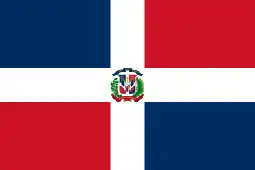Handspring double salto forward tucked
The handspring double salto forward tucked, known as a Produnova in women's artistic gymnastics and a Roche in men's artistic gymnastics,[1][2] is a vault consisting of a front handspring onto the vaulting horse and two front somersaults in a tucked position off it.

Men's Artistic Gymnastics
The first person to complete the vault was Cuban gymnast Jorge Roche in 1980.[1]
23 Roche vaults were performed during the 2000 Summer Olympics.[3]
By 2010, male gymnasts had developed more difficult variations by performing it piked or with twists.[4]
Women's Artistic Gymnastics
Under the 2017–2020 Code of Points (artistic gymnastics) for WAG, the vault has a D-score of 6.4,[5] and is considered one of the hardest vaults ever performed in women's artistic gymnastics.[6] It currently ties for the highest D-score on this apparatus with the Biles vault. It is named after Yelena Produnova of Russia, who was the first woman to complete it successfully in 1999.[7] Produnova's coach, Leonid Arkayev, bet her that she could not perform the vault.[1] The D-score of the Produnova has been slowly reduced over the quads from 7.1 (2009–2012) to 7.0 (2013–2016) and now 6.4 (2017–2020).
The vault is dangerous because a gymnast could break her neck if she fell short of two rotations. At the 2016 Summer Olympics, Uzbek gymnast Oksana Chusovitina attempted the Produnova but fell.[8] The vault is termed the "vault of death" due to its high level of difficulty and likelihood of injury.[9][10][11] Asked why she did not perform the vault, Simone Biles stated, "I’m not trying to die."[8]
Gymnasts who have successfully completed the Produnova
 Yelena Produnova (RUS)[12] (1999)
Yelena Produnova (RUS)[12] (1999) Yamilet Peña (DOM)[13] (2011)[14]
Yamilet Peña (DOM)[13] (2011)[14] Fadwa Mahmoud (EGY)[14][15] (2014)
Fadwa Mahmoud (EGY)[14][15] (2014) Dipa Karmakar (IND) (2014[16][17] and 2016)[8]
Dipa Karmakar (IND) (2014[16][17] and 2016)[8] Oksana Chusovitina (UZB)[14]
Oksana Chusovitina (UZB)[14]
References
- "The Produnova vault: a leap for Artistic Gymnastics at the 1999 Summer Universiade". www.fisu.net. Retrieved 5 October 2022.
- Čuk, Ivan; Ferkolj, S. M. (2012). "Changes in technique of handspring double salto forward tucked performed on horse and vaulting table". Acta Kinesiologiae Universitatis Tartuensis. 13: 20. doi:10.12697/akut.2008.13.02.
- Takei, Yoshiaki (2007). "The roche vault performed by elite gymnasts: somersaulting technique, deterministic model, and judges' scores". Journal of Applied Biomechanics. 23 (1): 1–11. doi:10.1123/jab.23.1.1. ISSN 1065-8483. PMID 17585174.
- Ferkolj, M. (2010). "A kinematic analysis of the handspring double salto forward tucked on a new style of vaulting table". Science of Gymnastics Journal. 2 (1): 35–48.
- "2013 FIG Vault Value Table" (PDF). USA Gymnastics. FIG. Retrieved 20 August 2016.
- "Exploring The New Code: Women's Vault". Gymnastike. 27 September 2012. Archived from the original on 8 August 2014. Retrieved 1 August 2014.
- Cohen, Ben; Radnofsky, Louise (7 August 2016). "The Vault That Is Too Wild for Simone Biles". The Wall Street Journal. Retrieved 2016-08-07.
- Sloat, Sarah. "Why Simone Biles Won't Attempt the "Vault of Death"". Inverse. Retrieved 5 October 2022.
- Roman Stubbs (14 August 2016). "Hoping to beat Simone Biles, 41-year-old Uzbek gymnast attempts the 'vault of death'". Washington Post.
- "Why Dipa Karmakar's Produnova is a vault of death". DNA India. 19 April 2016.
- Daniel Tran (14 August 2016). "Two gymnasts attempt the 'Vault of Death' (Video)". Yahoo Sports.
- "Elena Produnova Sticks World's Most Difficult Vault". WOGymnastika. 9 June 2013. Retrieved 1 August 2014.
- Lawrence, Blythe (8 October 2012). "Memorable Moments From Prelims". ESPN. Retrieved 1 August 2014.
- Talwar, Sushant (13 August 2016). "'Produnova', The 'Vault Of Death'; Only 5 Women Have Nailed It". TheQuint. Retrieved 5 October 2022.
- "video: Fadwa Mahmoud (EGY) 14.950". youtube. 29 March 2014. Retrieved 1 August 2014.
- "After a flight, a landing: Why Dipa Karmakar's medal in Commonwealth Games is its bravest bronze". The Indian Express. 2014-08-24. Retrieved 2016-04-20.
- "Why Dipa Karmakar's Produnova is a vault of death | Latest News & Updates at Daily News & Analysis". dna. Retrieved 2016-04-20.